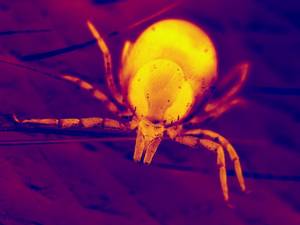What Are Ticks?

Ticks are blood-sucking parasites which feed on humans and domestic pets. Most ticks live in forest or scrub areas and cause problems during the summer months. Ticks can transmit a number of diseases, including Lyme Disease and Rocky Mountain Spotted Fever, in their saliva when they bite a host.
Ticks, more commonly found on dogs than on cats, can be a serious problem in some parts of the US.
The most common areas of infestation are your pet's head, neck and ears, which are much harder to scratch or groom. When ticks bite, they can transmit many serious diseases, including Lyme Disease, Rocky Mountain Spotted Fever, Tularemia, Babesiosis and Ehrlichiosis. They can also provoke skin inflammation and allergic reactions. On rare occasions heavy infestations lead to anemia, or tick-bite paralysis.
Adult ticks can be seen with the naked eye, while juvenile stages are only just visible. Ticks are arachnids, like spiders, scorpions and mites. They have four life stages: egg, larvae, nymph and adult, though some species have more than one larval or nymph stage. Ticks lack the body segments or distinct head apparent on insects. Instead they have a fused head and body entity together with legs jutting out sideways towards the front of the body. Larvae have six legs (three pairs), while nymphs and adults sport eight legs (in four pairs).
|
"Common hard tick adults can live for months away the host - some up to two years!"
|
Ticks eat blood, and can consume large volumes of this relative to their body size. Their blood-sucking baheaviour is known as "engorgement", and their outer shell is usually heavily folded to allow the body to expand during feeding. Hungry ticks look like tiny raisins, while engorged ticks look more like black grapes. Depending on the species adult ticks can be up to 20mm long, while unfed larvae are about 1mm in length.
There are two main types of ticks: hard ticks and soft ticks. Virtually every species targetting dogs and cats in the US are hard, or ixodid ticks, which have a hard shield (or scutum) on their back and mouth parts projecting outwards from their head. Some species also have cuticle indentations at the rear of their bodies (called festoons) to allow for expansion when they feed. Each life stage only feeds once, with the body increasing in weight by up to 100 times.
|
Anti-tick treatments
|
Pet Shed's most popular solutions for ridding your pet of ticks
|
Hard ticks secrete a cement-like substance in their saliva to help them attach themselves before eating. They are slow feeders, taking several days to engorge on the host animal's blood. During this time they continue to secrete saliva, which also contains substances to break down tissues, desensitize the skin and prevent the blood clotting. Unfortunately the saliva is also the means though which other diseases are also transmitted. Once feeding is complete, ticks secrete enzymes that digest the cement so they can detach from the host.
Ticks vary in terms of the number of different hosts they utilize and the specificity they have for a particular species of host.
Those known as 'one-host ticks' spend their entire development from larva to adult on one host animal. With 'two-host ticks' the larva and nymph develop on one host and the adult lives on another. With 'three-host ticks', each stage of development (larva, nymph and adult), takes place on a different host.
The complete tick life cycle can take from three months to three years, depending on the species and the climate conditions. Common hard tick adults can live for months away the host - some up to two years!
 Every
dog-related tick (and some cat) in the US are three-host ticks. Importantly, while domestic dogs and cats are
often
the host for the adult ticks, wild animals are the hosts for earlier tick stages. Many of these wild hosts carry
diseases which the tick can pick up when feeding, which remain in the parasite when it molts from one stage to the
next. This means the disease can be passed to the cat or dog when the tick feeds on its blood.
Every
dog-related tick (and some cat) in the US are three-host ticks. Importantly, while domestic dogs and cats are
often
the host for the adult ticks, wild animals are the hosts for earlier tick stages. Many of these wild hosts carry
diseases which the tick can pick up when feeding, which remain in the parasite when it molts from one stage to the
next. This means the disease can be passed to the cat or dog when the tick feeds on its blood.
The main hard tick species of concern in the U.S.A. are:
- the Deer tick, Black-legged Tick or Lyme Disease Tick ( Ixodes scapularis)
- the Brown Dog Tick (Rhipicephalus sanguineus)
- the Lone Star Tick (Amblyomma americanum)
- and the American Dog Tick (Dermacentor variabilis)
As with heartworm, prevention is better than cure. There are many effective prevention options available on the market. Ticks, like many other parasites, tend to be a seasonal problem with their numbers peaking in warmer weather.
The use of tick prevention products such as Frontline, collars containing amitraz or dips, or permethrin-based products is recommended throughout the tick season, in conjunction with daily inspections. Your local veterinarian will be able to advise you the length of the tick season in your state and which is the best prevention option for your pet
|
References
|
| Farley D. Fighting Fleas and
Ticks. In: FDA Consumer. US Food and Drug
Administration.
30:6, 1996. http://www.fda.gov Payne, P.A., Dryden, M.W., Carter, G.R. External Parasitic Diseases of Dogs and Cats. In: A Concise Guide to Infectious and Parasitic Diseases of Dogs and Cats. International Veterinary Information Service, Ithaca NY. www.ivis.org Tilley L.P., Smith, F.W.K. The Five Minute Veterinary Consult Canine and Feline. Second Edition. Lippincott Williams & Wilkins, Baltimore, 2000. Merck Veterinary Manual. Merck & Co., Inc. Whitehouse Station, NJ, USA, 2006 Vredevoe L. Background Information on the Biology of Ticks. Department of Entomology, University of California, Davis. http://entomology.ucdavis.edu What you should know about External Parasites. American Veterinary Medical Association. Schaumberg, IL. www.avma.org |